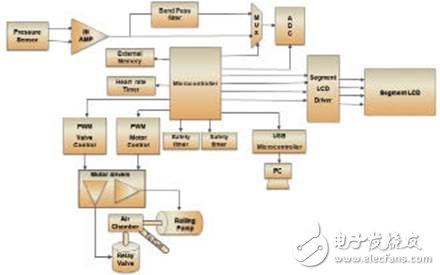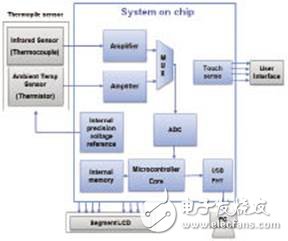As is well known, portable medical electronics have been greatly developed and widely used in recent years. More and more new products are already on the market. The products that are effective and can be mass-produced are those that are simple in design and superior in performance, so as to reduce the cost of equipment. To do this, designers need to consider power consumption, cost, size, FDA certification of the device, and other factors.
A typical portable medical electronic system consists of the following parts: analog front end (for data acquisition), amplifiers and filters (for signal conditioning), analog to digital converters and sensors (for signal acquisition), and buttons (for Accept user feedback), microcontroller (execution algorithm), and a variety of interfaces, such as LCD monitors, USB ports, and more. Traditional design requires all the required components to be placed on the PCB. This approach increases the BOM, PCB complexity, and design cycle of the entire system. The use of discrete devices is also not conducive to IP protection because it can be easily copied.
The design and production of portable medical devices is also regulated by the Food and Drug Administration (FDA). This means that their design and production must follow an accurate process archive, performance must meet the documentation requirements, and must pass development tests, mass production tests and field applications. A national food and drug administration requires that devices used in medical devices be available for the next five years. This spurs developers to reduce the overall device count for easier FDA certification.

Figure 1 Traditional design of blood pressure monitor
Figures 1 and 2 show a typical blood pressure monitor (BPM) and a non-contact digital thermometer using a traditionally designed solution architecture.

Figure 2 Traditional design of non-contact digital thermometer
Traditional scheme
A typical blood pressure monitor uses a differential pressure sensor to measure the pressure in the cuff or arm. This sensor is used as an output, only a few tens of microvolts (30μV ~ 50μV), the output pressure signal needs to be amplified with a high gain amplifier to achieve a good common mode rejection ratio (CMRR). Typically the gain and common mode rejection ratios need to be approximately 150 and 100 decibels, respectively. The pulse signal of the pressure signal has a frequency between 0.3 Hz and 11 Hz and an amplitude of about several hundred microvolts. This type of oscillation can be extracted by a bandpass filter with a gain of 200 and a cutoff frequency of 0.3 Hz to 11 Hz. A 10-bit ADC with a speed of 50 Hz is used to digitize the pressure sensor and vibration signal. Two timers are used to calculate the heartbeat and implement a safety timer. The safety timer is used to adjust the pressure to remain in the target arm for a certain period of time. The security timer is part of the security rules in the AAMI standard. A microcontroller core uses various algorithms to calculate its systolic and diastolic pressure values. The PWM motor is driven to expand and contract the cuff.
A typical non-contact digital thermometer uses a sensor (or thermocouple thermocouple) that consists of a thermocouple (used to measure the thermocouple temperature) and a thermistor (used to measure the ambient temperature). film. The thermocouple generates a DC voltage based on the voltage difference between the nodes. The output of the thermocouple is kept at a few microvolts. The thermocouple signal is amplified by a low noise precision amplifier. A voltage divider is formed by a thermistor and an external precision voltage regulator. This voltage divider is used to convert the change in the thermistor voltage to temperature. The thermocouple and thermistor voltages are used to calculate the thermocouple and ambient temperature. The voltage is obtained by a formula given by the sensor manufacturer or a pre-stored look-up table to obtain the temperature. The ambient temperature plus the thermocouple temperature is the final temperature measurement.
Of course, in the above applications, other peripheral circuits are also needed, such as field LCD driver, real time clock RTC, button, EEPROM and USB.
Devices external to the microcontroller, such as sensors, analog-to-digital converters, LCD drivers/controllers, USB controllers, filters, and amplifiers, are peripheral devices. These devices can be connected to the microcontroller through a general-purpose input/output port GPIO or a dedicated pin. The more external separation devices, the more limitations and constraints designers must consider, such as device inventory management, the complexity of multi-layer PCBs, FDA certification for each device, and increased design/development time, which is not conducive to analog IP protection. and many more.
Scheme based on system on chip
The design of today's System-on-Chip (SoC) architecture provides a new way of thinking for portable medical electronics. Using a system-on-a-chip design can bring a lot of added value. The design of Figures 3 and 4 depicts an implementation of a blood pressure monitoring and contactless digital thermometer using a system on a chip.

Figure 3 Blood pressure monitoring program using the system on chip
Using a blood pressure monitoring device based on a system-on-a-chip can simplify the design and achieve better results. The system-on-chip can integrate the high gain amplifiers required for the design. The oscillating pulses can be extracted by an integrated analog/digital filter. An analog-to-digital converter ADC in the system on chip can be used to digitize data. The integrated CPU core provides the processing power to handle the advanced process algorithms required. The device can also integrate field LCD driver (for display), EERPROM (data log), real-time clock (time stamp), full-speed USB (as PC interface), direct memory access DMA (with CPU data exchange) and capacitive sensing buttons (Can replace mechanical buttons). Timers in the system-on-a-chip can be used to calculate heart rate and process safety functions, and an integrated pulse width modulator PWM can be used to control the motor. The system-on-chip can also operate at a unique wide operating voltage and achieve lower power consumption, a feature that is ideal for battery-powered devices.

Figure 4 Non-contact digital thermometer solution using on-chip system
For infrared thermometers, the system-on-chip also integrates the required amplifiers and analog-to-digital converters (detecting microvolt variations). The precision reference voltage inside the system-on-chip provides a stable, accurate reference for the sensor. The system-on-chip also integrates other functions, including field LCD driver, EEPROM, real-time clock RTC, USB interface, capacitive sensing, and more.
As mentioned above, the system on chip integrates most of the peripheral components required for portable medical electronics applications. This not only reduces external components, but also protects analog IP because it integrates most of the analog components into the chip. And, fewer devices mean less PCBs, shorter design times, and faster time to market. The power supply of different peripheral devices in the chip can be set to different modes separately, so system power management becomes simpler and more efficient. The system-on-chip can also be dynamically reconfigured, which also reduces cost and time and facilitates redesign or design changes. Most importantly, using a system-on-a-chip architecture simplifies device listings, making FDA certification easier. All types of portable medical electronic devices - blood glucose meters, blood pressure monitors, portable electrocardiographs, etc., can be implemented using this method.
For example, Cypress's PSoC products (programmable system-on-chip) can be used to tailor handheld applications such as blood pressure monitors, blood glucose meters, and pulse oximeters. PSoC3/5 integrates 8051 / ARM cortex M3 core (can work at 33 MIPS and 100 DMIPS), amplifier, dedicated digital filtering module, configurable Delta Sigma analog-to-digital converter, can drive 736 field LCD driver, capacitive Touch-sensitive buttons and proximity detection, 2KB of EEPROM, full-speed USB 2.0 and many other features truly achieve a single-chip solution. These, together with the PSoC Creator integrated development environment (a programmable IP module that has been pre-built for each function, provides all the design tools needed), allowing product designers to program their products as they wish. Shorten the design cycle.
In general, the use of a system-on-a-chip makes portable medical electronic design simpler, protects intellectual property, provides a novel and unique way to make features more personal, and makes FDA certification easier.
Barbecue machine is a barbecue food machinery and equipment, its main function is to do all kinds of barbecue products. Mainly used for barbecue shops, mobile barbecue and so on.
The use of rotary grill grill grilled after a piece of barbecue from the barbecue, accompanied by salad dishes, ingredients into a special made in the bread. Visibility, on-site production, and popular in Europe and the United States. Become one of the mainstream street food fast food.
1 power: the range of 800-1600W, according to the actual situation. 2 grilled food: steak, shrimp, vegetables, ham and so on. 3 functions: 3.1 baking pan with a raised stripes, relying on the protruding stripes to bake the food, there will be drainage structure, slope or drain hole. 3.2 baking time is about 3-5 minutes. 3.3 thermostat is adjustable, according to the different food or personal taste to adjust the different. 3.4 heat pipe: According to the different grades of products, choose different specifications of the heating pipe. Generally fixed in the back of the heating plate, using high temperature stainless steel tube or nickel-chromium alloy tube INCO840, the latter cost higher. 3.5 generally do not need PCB control, FireWire to increase the temperature insurance. 3.6 within the wiring: the general use of hidden lines, hidden in the activities of the hinge of the shaft. 3.7 Other: need to take oil device, a separate configuration or drawer type oil box. 3.8 turn on the power, the red power light, the machine warm, until the green light into the food, wait 3 to 5 minutes.
Electric BBQ Grill,Smokeless BBQ Grill,Electric Chicken Grill,Vertical Electric BBQ Grill
Ningbo APG Machine(appliance)Co.,Ltd , http://www.apgelectrical.com
